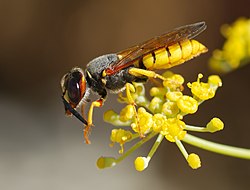| Murellen mountains, Murellen gorge and Schanzenwald forest | |
|---|---|
 Murellenberg and Schanzenwald | |
| Highest point | |
| Peak | Murellenberg |
| Elevation | 62 m (203 ft) |
| Coordinates | 52°31′0″N13°13′30″E / 52.51667°N 13.22500°E |
| Geography | |
 | |
| Location | Ruhleben , Berlin-Westend, Germany |
| Geology | |
| Rock age(s) | approx. 20000 years, Ice Age |
The Murellenberge, the Murellenschlucht and the Schanzenwald are a hilly landscape formed during the Weichselian Ice Age in the Berlin district of Ruhleben in the Westend part of the District of Charlottenburg-Wilmersdorf. The area is located to the west of the Olympic site. The largest part of the upslope and terminal moraine landscape is designated as nature reserve Murellenschlucht und Schanzenwald, which is part of the biotope network Fließwiese Ruhleben, Tiefwerder Wiesen and Grunewald. About 1.5 kilometers northeast of the area (from Murellenberg) is the natural monument Murellenteich.
Contents
- Location of the area and etymology
- Geology and climate
- North band of the Teltow
- Boulders
- Clima
- Natural development and urban interventions
- Lost connection to the Grunewald (south)
- Former northern boundary of Elsgraben
- Integration of the Murellenteich natural monument (north-east)
- Schanzenwald
- Shooting site and memorial
- Execution site of the Nazi military justice system
- Symbol
- Nature conservation, flora and fauna
- Murellen Gorge and Schanzenwald nature reserve
- Flora
- Fauna
- Maintenance measures
- Outlook: Concept of an elevated path on the Teltownord ridge
- External links
- Literature
- References
The Murellenberge (often referred to as 'Murellenberg', formerly: Morellenberge) are part of the Teltownordband, which forms the northernmost spur of the Teltow plateau to the Berliner Urstromtal. The connection of the original natural area was largely lost due to urban development. The up to 62 meter high mountains and the up to 30 meter incised basin have a diverse and endangered flora and fauna, especially in their dry grassland areas. Used as a military and police area for over 150 years, the forest stands in the Schanzenwald were able to develop almost undisturbed. The Waldbühne was built in the eastern part of the ravine in 1936 under the direction of the architect Werner March. The National Socialists set up an execution site in the mountains for deserters and so-called "wehrkraftzersetzer". The Installation Memorial to the Murdered by Nazi Military Justice on the Murellenberg by the artist Patricia Pisani from 2002 commemorates the victims.















